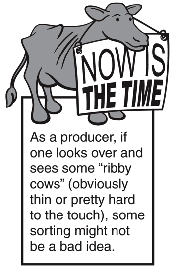
Kris Ringwall
Beef Talk
Are your cows ready for breeding?
Well, what is, is. After a long and fairly nice winter, cattle are moving slowly to the cool-season grasses. Some are waiting to calve; however, most of the cows have calved, so the pairs are in the process of being worked.
This means breeding is the next chapter in the management notebook. Are the cows ready? Also, do not forget to ask if the bulls are ready. Breeding preparation actually does not start now, because a cow's condition is the first step to evaluating readiness. Actually, a cow's condition should have been evaluated last fall as the cow came home.
Those cows that needed some extra feed should have been boosted while dry and not nursing a calf last winter. However, there always is the "I should have done this or that," so in reality, now is the time for the last check to make sure the cows and bulls are in good condition for the upcoming breeding season.
Of all the cows and bulls that are going to be mated in breeding pastures in late May and early June, now is an excellent time to ask some questions about their readiness for breeding. In a perfect world, cattle never should be out of shape for breeding.
Weather and feed supplies should be managed to maintain cows and bulls in good condition. However, that certainly is not always the case. This spring has been good in the upper north-central Great Plains. However, in many parts of the country, feed still is scarce and the cattle are thin.
For typical cattle at 1,300 pounds (lb.) of body weight, dry-matter consumption is 25 to 30 lb. or more a day, depending on stage of pregnancy and milk production. If the cow is dry and pregnant, she will be at the lower end of total feed needs. If she is in lactation and a high-milking cow, she would be at the upper end.
A daily dry-matter intake just shy of 30 lb. of hay per day (primarily a good green grass hay mixed with perhaps 20% alfalfa) generally will maintain cows and bulls in good condition. However, what is, is, and the cows that are nursing calves today probably are consuming all they can get in their mouths.
 As a producer, if one looks over and sees some "ribby cows" (obviously thin or pretty hard to the touch), some sorting might not be a bad idea. Body condition scores (BCS) lower than a 5 (see www.cowbcs.info) should have a second look. If the score is lower than a 4, rebreeding flags start to pop up.
As a producer, if one looks over and sees some "ribby cows" (obviously thin or pretty hard to the touch), some sorting might not be a bad idea. Body condition scores (BCS) lower than a 5 (see www.cowbcs.info) should have a second look. If the score is lower than a 4, rebreeding flags start to pop up.
Every herd has an occasional thin cow, but it should not be the norm. If the hay pile is short or the cool-season grass still dry, any cow that does not consume her required daily dry-matter intake, such as 30 lb. of dry matter in the form of hay or grass, will go backward and continue to lose weight prior to bull turnout.
More than likely, as body weight and condition go down, she will not resume any reproductive activity until she can replenish her body's needs, as well as continue to feed a calf. Even within a well-conditioned cow herd, 1,300-lb. cows with a BCS of 6 can lose 100 lb. or more at calving and be turned out on grass closer to 1,100 lb. and a BCS of 5. At the Dickinson Research Extension Center, cows easily can lose almost 5% of their body weight in early lactation.
Various studies would indicate that one body condition score is equal to 60-80 lb. of actual weight, which would be typical of what we see at the center once one includes weight loss at calving.
Now it's time for a managerial timeout. From a producer perspective, after reviewing the feed data at the center (average feed delivery of 32-33 lb. per cow per day), these cows should be in suitable condition.
However, if cows are losing condition, the current nutritional protocol is not meeting their needs. The cows either are milking more than predicted or the environment has been rougher than thought. The real answer is probably somewhere between the two, so do not hesitate to call a good cattle nutritionist for proper ration supplement formulations.
Regardless of the reason, now is the time to provide a 20% increase in nutrition (prebreeding flush) to prepare for breeding. It's also time to sort off the BCS 3 and 4 cow-calf pairs and feed them separately so you can give them the nutritional attention they need.
There is nothing unique about feeding cows. The bottom line is to monitor your cows to avoid surprises. If you need to, whistle for the feed wagon.
May you find all your ear tags.
 Your comments are always welcome at www.BeefTalk.com. For more information, contact the North Dakota Beef Cattle Improvement Association (NDBCIA) Office, 1041 State Ave., Dickinson, ND 58601, or go to www.CHAPS2000.com on the Internet.
Your comments are always welcome at www.BeefTalk.com. For more information, contact the North Dakota Beef Cattle Improvement Association (NDBCIA) Office, 1041 State Ave., Dickinson, ND 58601, or go to www.CHAPS2000.com on the Internet.










